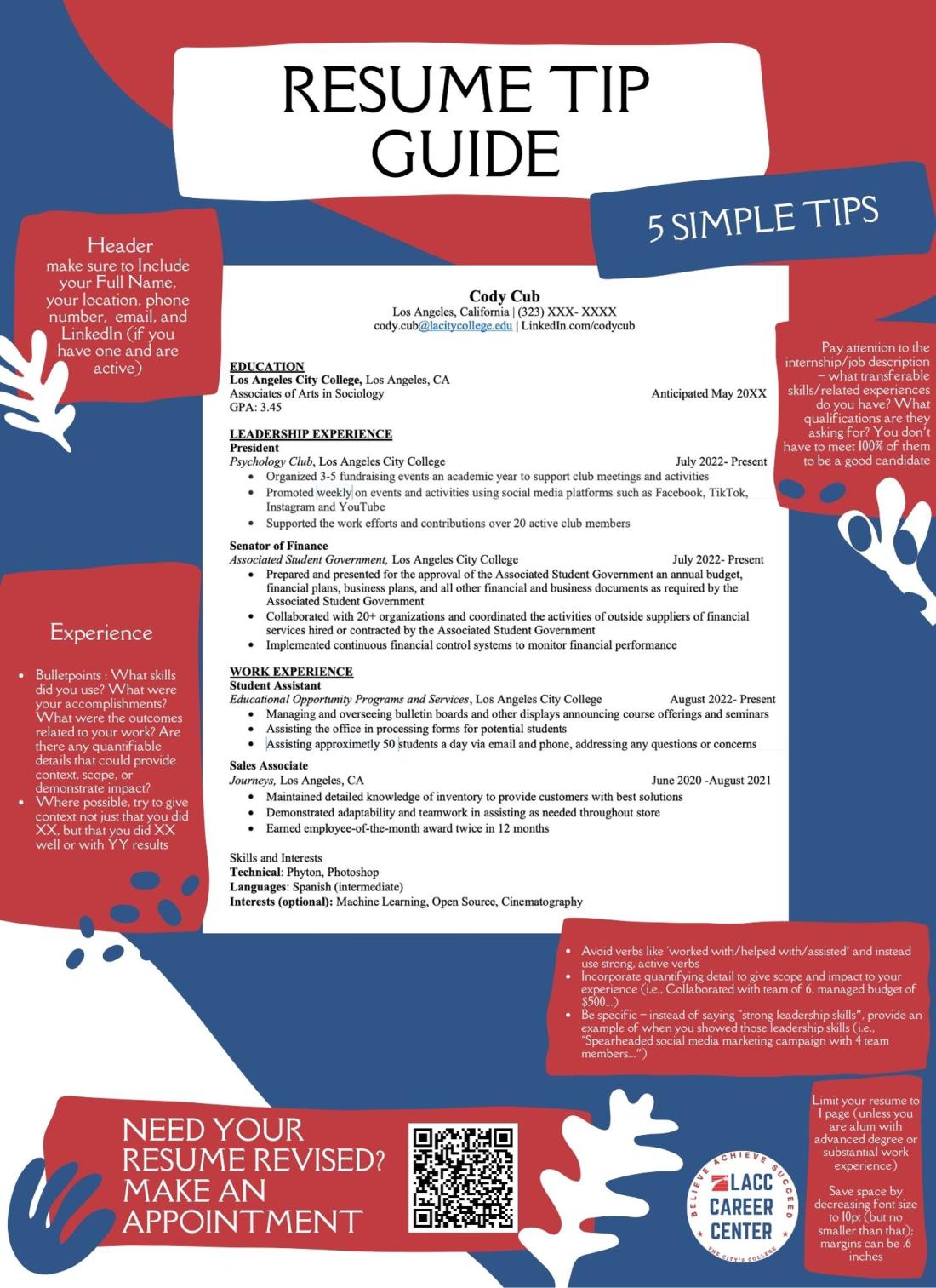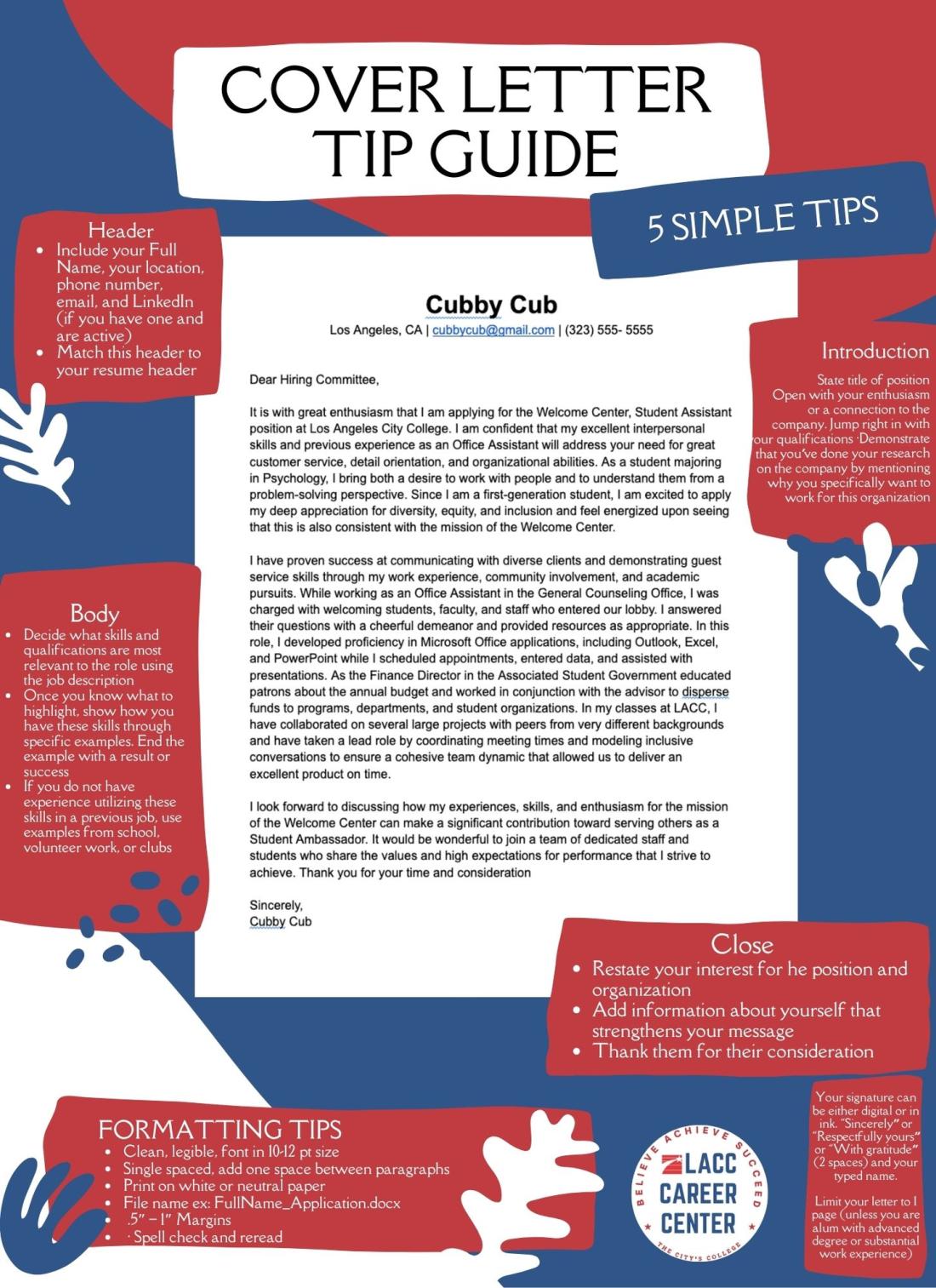Resume & Cover Letter Writing
Effective Resume Writing
Getting Started
A resume serves as a concise and tailored document that outlines an individual's professional journey, skills, and qualifications. It is a crucial component in the job application process, acting as a personal marketing tool to present one's candidacy to potential employers. A well-crafted resume not only provides a snapshot of an individual's work history, education, and skills but also strategically showcases their achievements and impact in previous roles. Employers use resumes to quickly evaluate whether a candidate possesses the necessary qualifications for a specific role. Therefore, the importance of a resume lies in its ability to make a strong and positive first impression, serving as the gateway for job seekers to secure interviews and advance in the hiring process.
Here are some key things to know about resume writing:
- Keep the resume as concise as possible as it may be among a stack of resumes that will be viewed for no more than 30 seconds.
- Try to use words and relative experiences that you have which match the job description. If the keywords/skills are missing, your resume may be rejected.
- Don't lie or embellish the truth (employers will check your references).
- Be mindful of your spelling and grammar.
- Avoid first person pronouns “I” “Me” or “We”.
- Use a dictionary or thesaurus to avoid repetitive wording.
- Use a professional looking design that enhances readability. Avoid highly-stylized resume templates as these are not always accessible to resume scanning software.
Components of a Good Resume
Personal Information
Your name, address, city, state, cell phone number and email address should be highly visible, at the top of the page. *Note: E-mail address and cell phone voicemail must be professional.
Objective (optional)
Not all employers require an objective. An objective identifies which position you are seeking. Place an objective on your resume when you are applying for a specific position.
Summary of Qualifications
The qualifications section delivers an impact at the top of your resume – it’s your first impression. The qualification statements should be one to three sentences in length and match your previous successes to the target job description. Be as specific as possible in your objective statement. Include quantifying information in your summary. Place most important words first since the scanner may be limited in the number of words it reads.
Summary Example:
Dynamic Sales Representative with a track record of exceeding sales quotas by 20%+. Proficient in consultative sales and relationship building with exceptional negotiation skills. Seeking floor sales position at ABC Company.
Experience
This is where you will share descriptions of past work experiences. Try to avoid just listing what you did; rather, focus on sharing what your impact was. Quantify anything you can. For example, rather than saying, “assisted customers with check out process” say “accurately maintained cash drawer with approximately 200 transactions per day” Be mindful of the verbs you use to begin your statements. Choose specific and impactful verbs. Do not repeatedly use the same verb(s). Use present tense for a role you still have & past tense for past roles.
While the most common type of experience shared is past work experience, also consider including internship experience, leadership experience (in community or extra-curricular settings), and volunteer experience.
For each experience, list the name of the organization, the dates you were active with them, and your title/role. Follow this with bullet points that describe your responsibilities and achievements.
Format each experience the same way (for example, use the same font size, and use of bold or italic text in the same way for each experience listed).
Education
List all collegiate degrees or certificates in reverse chronological order. Include school name, city and state (if not in name of school), degree, anticipated graduation date, majors, minors, and GPA (optional). You may also list relevant course work, Dean’s List, and scholarships. Study abroad would also be listed under this section using the same format.
List GPA if it is 3.0 or above. You can also list your major GPA if that is over 3.0 but your overall is below that.
References
“Reference available upon request,” can be omitted. It is understood that you will supply references. Create a separate reference page and bring it with you to the interview. Include the reference name, title, organization/company name, business address, phone number, and email of each reference. Include only those persons who have agreed to serve as a reference for you. List all your personal information at the top of this page.

Resume Writing with Little to No Work Experience
There comes a time in most people’s lives when they are asked to present their resume, but they don’t yet have any work experience to put on their resume! If you are in this situation, here are some ideas of what you can put on your resume. Also, please find the sample resume below.
- Header with your personal information. This is the same information you would include on any resume. Include your name, city, phone, and email. This information is included at the top of the page and often in a larger or different font than the rest of the resume.
- Education: Include what you have already accomplished & what you are working towards. Example:
Marshall High School, Los Angeles, CA: High School Diploma June, 2024
Los Angeles City College: Associate of Science, Economics, Expected June, 2026
- Experience: This section often lists past or current paid work experience, but there are other types of experience you can include if you won’t have paid work experience, or if you have little paid work experience:
- Hustling Experience - do you have experience babysitting, with yardwork, helping a family member with their business, or anything else that you received money for? List this type of experience as work experience.
- Leadership Experience - have you held any leadership positions in school clubs or community service/church organizations?
- Volunteer Experience - include any experiences you have had with past clubs, church, or community groups.
- Sports or Extracurricular Experience: List any involvement in extracurricular experiences.
4. Relevant Coursework: List any classes you are taking or have completed that relate to the job you are applying to. List the title of the class, not the class number.
Example: Managerial Accounting, not Accounting 021.
5. Skills: List any skills or attributes you have that can be used in a variety of work settings. For example, languages spoken other than English, software skills, general skills such as reliability, ability to work well on a team, or ability to learn quickly, to name a few.
Challenge yourself to frame non-work activities into work assets. For example:
Captain of a club = leader
Not a captain, but a regular attendee = commitment and reliability
Volunteer at an event/fundraiser/charity event = contribution and collaboration.
Good grades? = hard worker
Awards: List any awards or recognitions you have earned. Examples can include scholarships earned, academic honors, and/or extracurricular recognitions.
Cover Letter Guide
Think of a cover letter as a formal introduction of yourself to a potential employer. It should not include as much overall information as your resume, but it should expand upon the most important points in your resume. It should also clearly state which job you are applying for, name anyone who referred you to the job at the company being applied to, and explain (with one or more examples) why you are a great fit for the job in question.
The cover letter should be no more than one page long, with three to five short paragraphs.
The first paragraph should clearly state the position you are applying for, as well as any degrees or certifications you hold that may be required for the position. You want the person reading the letter to know right away that you are qualified for the position.
The next one to two paragraphs should focus on why you are a great fit for the position. Look at the job description and find the top 3-5 desired or required qualifications. Explain (with examples) you hold these qualifications. For example, for a job at a help desk, you could say, “As a Help Desk professional, I know it is integral to explain complex processes in a manner that our clients understand. In my past role as an associate at YDJ Corp., I created written prompts to remind clients of computer maintenance schedules which helped create more seamless communication between IT and end users.”
Repeat this to provide the employer with 1-4 examples of HOW you meet their desired job qualifications.
The last paragraph should be short and is a brief call to action or look forward to the next steps. For example, “I look forward to meeting with you to discuss how I can contribute to HGY Company.”
Formatting:
Cover letters are formatted as formal business letters. This means you should include your own contact information and include the name of the person the letter is addressed to and the name and mailing address of the company being applied to at the top of the letter. Be careful to change this information for each letter you send!
Save the letter in a .pdf format to ensure your formatting is consistent for the person reading your letter. Always include your name in the file name so employers can easily identify your application materials: Smith_Sydney_CoverLetter.pdf, for example.
An example of a cover letter is included below.
You are encouraged to meet with a career counselor or intern to help your customize your cover letter! Cover letters are a skill that takes practice and we are happy to meet with you as your craft your application materials.
